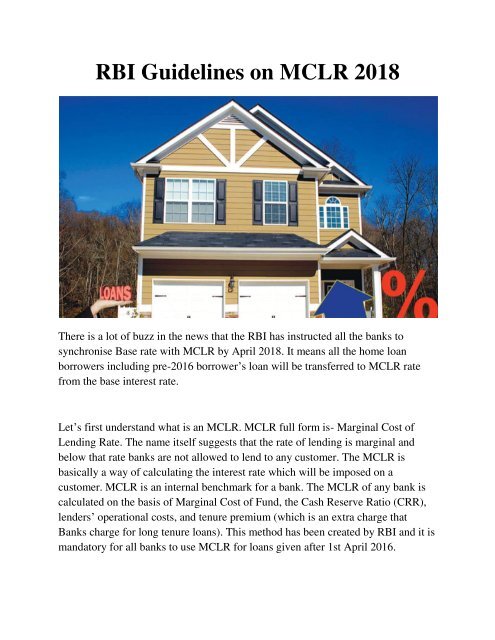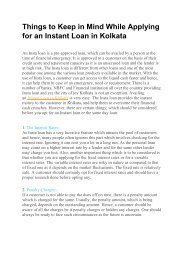RBI Guidelines on MCLR 2018
There is a lot of buzz in the news that the RBI has instructed all the banks to synchronise Base rate with MCLR by April 2018. It means all the home loan borrowers including pre-2016 borrower’s loan will be transferred to MCLR rate from the base interest rate. Blog: https://amritaagarwalblog.wordpress.com/2018/02/08/rbi-guidelines-on-mclr-2018/ Apply for Loan: https://financebuddha.com/home-loan Facebook :https://www.facebook.com/financebuddha Twitter:https://twitter.com/financebuddha
There is a lot of buzz in the news that the RBI has instructed all the banks to synchronise Base rate with MCLR by April 2018. It means all the home loan borrowers including pre-2016 borrower’s loan will be transferred to MCLR rate from the base interest rate.
Blog: https://amritaagarwalblog.wordpress.com/2018/02/08/rbi-guidelines-on-mclr-2018/
Apply for Loan: https://financebuddha.com/home-loan
Facebook :https://www.facebook.com/financebuddha
Twitter:https://twitter.com/financebuddha
You also want an ePaper? Increase the reach of your titles
YUMPU automatically turns print PDFs into web optimized ePapers that Google loves.
<str<strong>on</strong>g>RBI</str<strong>on</strong>g> <str<strong>on</strong>g>Guidelines</str<strong>on</strong>g> <strong>on</strong> <strong>MCLR</strong> <strong>2018</strong><br />
There is a lot of buzz in the news that the <str<strong>on</strong>g>RBI</str<strong>on</strong>g> has instructed all the banks to<br />
synchr<strong>on</strong>ise Base rate with <strong>MCLR</strong> by April <strong>2018</strong>. It means all the home loan<br />
borrowers including pre-2016 borrower’s loan will be transferred to <strong>MCLR</strong> rate<br />
from the base interest rate.<br />
Let’s first understand what is an <strong>MCLR</strong>. <strong>MCLR</strong> full form is- Marginal Cost of<br />
Lending Rate. The name itself suggests that the rate of lending is marginal and<br />
below that rate banks are not allowed to lend to any customer. The <strong>MCLR</strong> is<br />
basically a way of calculating the interest rate which will be imposed <strong>on</strong> a<br />
customer. <strong>MCLR</strong> is an internal benchmark for a bank. The <strong>MCLR</strong> of any bank is<br />
calculated <strong>on</strong> the basis of Marginal Cost of Fund, the Cash Reserve Ratio (CRR),<br />
lenders’ operati<strong>on</strong>al costs, and tenure premium (which is an extra charge that<br />
Banks charge for l<strong>on</strong>g tenure loans). This method has been created by <str<strong>on</strong>g>RBI</str<strong>on</strong>g> and it is<br />
mandatory for all banks to use <strong>MCLR</strong> for loans given after 1st April 2016.
Recent announcement made <strong>on</strong> <strong>MCLR</strong><br />
The latest announcement <strong>on</strong> <strong>MCLR</strong> which has become a burning topic am<strong>on</strong>g the<br />
financial experts, as well as the home loan borrowers, is the <str<strong>on</strong>g>RBI</str<strong>on</strong>g>s announcement of<br />
linking all existing base rate home loans to <strong>MCLR</strong> with effect from 1st April <strong>2018</strong>.<br />
It means that after two years of introducing <strong>MCLR</strong>, now it has become mandatory.<br />
The announcement was made <strong>on</strong> Wednesday ( 7th Feb <strong>2018</strong>) and the objective of<br />
this change is to improve m<strong>on</strong>etary policy transmissi<strong>on</strong>. The deputy governor of<br />
the <str<strong>on</strong>g>RBI</str<strong>on</strong>g> N S Vishwanathan reported that the base rate and the <strong>MCLR</strong> will be<br />
“harm<strong>on</strong>ized and not equalized”.<br />
A base rate <strong>on</strong> a home loan is reviewed quarterly whereas an <strong>MCLR</strong> is reviewed<br />
m<strong>on</strong>thly. Both of these two rates have different ways of fixing it. Once the linking<br />
of the base rate and <strong>MCLR</strong> is d<strong>on</strong>e, it is likely that base rate will be reviewed <strong>on</strong> a<br />
m<strong>on</strong>thly basis as well.<br />
The interest rate <strong>on</strong> a credit was previously determined by the base rate. If there is<br />
a rate increase by <str<strong>on</strong>g>RBI</str<strong>on</strong>g> then bank used to increase the interest rate promptly, but<br />
when the rate of <str<strong>on</strong>g>RBI</str<strong>on</strong>g> falls down banks slow down the process of bringing the<br />
interest rate down.<br />
In the January 2017, the <strong>MCLR</strong> of almost all the banks were reduced by 80-90<br />
basis points because of a low repo rate. A basis point is a <strong>on</strong>e-hundredth of <strong>on</strong>e<br />
percentage point. But the base rate remained unchanged for many banks. It directly<br />
meant that banks were getting fund from <str<strong>on</strong>g>RBI</str<strong>on</strong>g> at a low cost but the same m<strong>on</strong>ey<br />
was disbursed to the general public at a high cost. Bank earned a high benefit in an<br />
unjustified manner. But the applicati<strong>on</strong> of <strong>MCLR</strong> ensures that the banks regularly<br />
revise the interest rate al<strong>on</strong>g with any change in <str<strong>on</strong>g>RBI</str<strong>on</strong>g> rates. So the ultimate<br />
beneficiary by implementing <strong>MCLR</strong> is the borrower himself.
A home loan interest rate is calculated by <strong>MCLR</strong> (or Base Rate) + Spread. Let’s<br />
say the <strong>MCLR</strong> is 9% then the interest rate will be 9%+ 0.25%( spread) = 9.25%. It<br />
was seen that banks would initially provide a low spread rate to attract the<br />
customers and after some time the spread is increased which directly affects the<br />
customers. After implementati<strong>on</strong> of <strong>MCLR</strong> banks are not allowed to change the<br />
spread unless there is a change in customer’s credit.<br />
Under the <strong>MCLR</strong> process, banks have to publish their <strong>MCLR</strong> rate at least five<br />
times in a m<strong>on</strong>th. The declarati<strong>on</strong> should be d<strong>on</strong>e overnight, <strong>on</strong>e m<strong>on</strong>th, three<br />
m<strong>on</strong>ths, six m<strong>on</strong>ths, <strong>on</strong>e year, two years, and three years rates each m<strong>on</strong>th.<br />
However, when it comes to lending <strong>on</strong> an <strong>MCLR</strong> basis, the interest rate of the<br />
home loan gets re-priced <strong>on</strong> a periodical basis.<br />
Now <str<strong>on</strong>g>RBI</str<strong>on</strong>g> has made it necessary to allow base rate borrowers to switch to <strong>MCLR</strong>.<br />
One can switch to <strong>MCLR</strong> with the same lender or the other opti<strong>on</strong> is to go for a<br />
refinance. With a refinance, a borrower can switch to the lender who is providing<br />
loans at <strong>MCLR</strong>. Switching from lender to lender or changing the mode of interest<br />
can be a chargeable <strong>on</strong>e. Banks may impose transfer charges to a borrower while<br />
applying for a transfer. So if <strong>on</strong>e’s home loan is near to end or <strong>on</strong>ly a few<br />
installments are remaining then <strong>on</strong>e can still c<strong>on</strong>tinue to be in base rate itself.


















